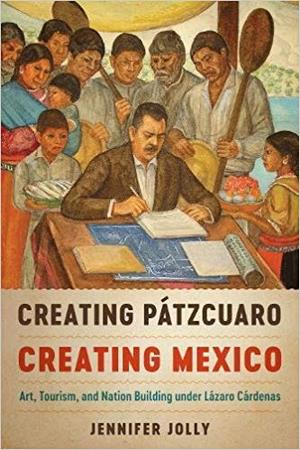Número de ficha: 146764
Me gusta
0
No me gusta
0
Para calificar el registro, es necesario acceder al sistema.
Ir a la página de acceso
- ISBN
- 978-1-4773-1420-3
- Clasificación DEWEY
- 972.37 JOL-c
- Autor
- Jolly, Jennifer , autor
- Título
- Creating Pátzcuaro, creating Mexico : art, tourism, and nation building under Lázaro Cárdenas / Jennifer Jolly
- Edición
- Primera edición .
- Lugar de publicación
- Austin University of Texas Press 2018
- Descripción
- xi, 340 páginas, 8 páginas de láminas sin numerar : ilustraciones (algunas a color) ; 24 cm.
- Tipo de medio digital o análogo
- sinmedio rdamedia
- Medio de almacenamiento
- volumen rdacarrier
- Bibliografía
- Incluye referencias bibliográficas (páginas 297-315) e índice
- Nota de contenido
- Seeing Lake Pátzcuaro, transforming Mexico -- Creating Pátzcuaro típico : architecture, historical preservation, and race -- Creating the traditional, creating the modern -- Creating historical Pátzcuaro -- Creating Cárdenas, creating Mexico.
- Nota de Resumen
- Presented thematically, this expansive work explores radical changes that resulted from postrevolution culture, including new internal migrations; a collective imagining of the future; popular biographical narratives, such as that of the life of Frida Kahlo; and attempts to create a national history that united indigenous and creole elite society through literature and architecture. While cultural production in early twentieth-century Mexico has been well researched, a survey of the common roles and shared tasks within the various forms of expression has, until now, been unavailable. Examining a vast array of productions, including popular festivities, urban events, life stories, photographs, murals, literature, and scientific discourse (including fields as diverse as anthropology and philology), Horacio Legrás shows how these expressions absorbed the idiosyncratic traits of the revolutionary movement.Tracing the formation of modern Mexico during the 1920s and 1930s, Legrás also demonstrates that the proliferation of artifacts--extending from poetry and film production to labor organization and political apparatuses--gave unprecedented visibility to previously marginalized populations, who ensured that no revolutionary faction would unilaterally shape Mexico's historical process during these formative years.
- Fuente de adquisición
- Rhian Yeh ; donación ; 10-2019
- Materia Nombre
- Cárdenas, Lázaro, , 1895-1970
- Materia
- Política y Cultura -- México
- Cultura y Turismo -- México
- Materia Nombre Geográfico
- Pátzcuaro, Michoacán de Ocampo -- Historia
- Mexico -- Politica y Gobierno -- 1910-1946
| etiq. | info |
|---|---|
| 001 | 19670627 |
| 005 | 20180714130413.0 |
| 006 | a |
| 008 | 191004s2018 txuaf rb s001 0 eng c |
| 010 | |a 2017025392 |
| 020 | |a978-1-4773-1420-3 |
| 040 | |aTxU/DLC|bspa|cTxU|erda|dDLC |
| 042 | |apcc |
| 082 | 00|a972.37|bJOL-c |
| 100 | 1 |aJolly, Jennifer|eautor |
| 245 | 10|aCreating Pátzcuaro, creating Mexico|bart, tourism, and nation building under Lázaro Cárdenas |cJennifer Jolly |
| 250 | |aPrimera edición |
| 264 | 1|aAustin|bUniversity of Texas Press|c2018 |
| 300 | |axi, 340 páginas, 8 páginas de láminas sin numerar |bilustraciones (algunas a color)|c24 cm. |
| 336 | |atexto|2rdacontent |
| 337 | |asinmedio|2rdamedia |
| 338 | |avolumen|2rdacarrier |
| 504 | |aIncluye referencias bibliográficas (páginas 297-315) e índice |
| 505 | 0 |aSeeing Lake Pátzcuaro, transforming Mexico -- Creating Pátzcuaro típico : architecture, historical preservation, and race -- Creating the traditional, creating the modern -- Creating historical Pátzcuaro -- Creating Cárdenas, creating Mexico. |
| 520 | |aPresented thematically, this expansive work explores radical changes that resulted from postrevolution culture, including new internal migrations; a collective imagining of the future; popular biographical narratives, such as that of the life of Frida Kahlo; and attempts to create a national history that united indigenous and creole elite society through literature and architecture. While cultural production in early twentieth-century Mexico has been well researched, a survey of the common roles and shared tasks within the various forms of expression has, until now, been unavailable. Examining a vast array of productions, including popular festivities, urban events, life stories, photographs, murals, literature, and scientific discourse (including fields as diverse as anthropology and philology), Horacio Legrás shows how these expressions absorbed the idiosyncratic traits of the revolutionary movement.Tracing the formation of modern Mexico during the 1920s and 1930s, Legrás also demonstrates that the proliferation of artifacts--extending from poetry and film production to labor organization and political apparatuses--gave unprecedented visibility to previously marginalized populations, who ensured that no revolutionary faction would unilaterally shape Mexico's historical process during these formative years. |
| 541 | |aRhian Yeh|cdonación|d10-2019 |
| 598 | |aOCTUBRE2019 |
| 600 | 10|aCárdenas, Lázaro,|d1895-1970 |
| 650 | 4|aPolítica y Cultura|zMéxico |
| 650 | 4|aCultura y Turismo|zMéxico |
| 651 | 4|aPátzcuaro, Michoacán de Ocampo|xHistoria |
| 651 | 4|aMexico|xPolitica y Gobierno|y1910-1946 |
